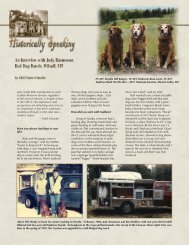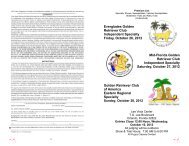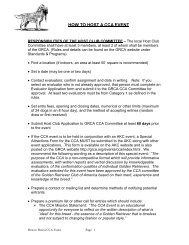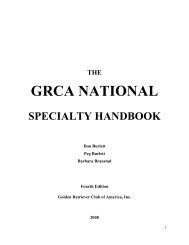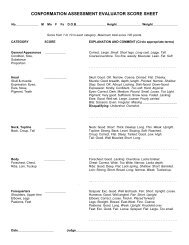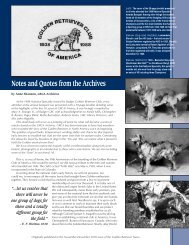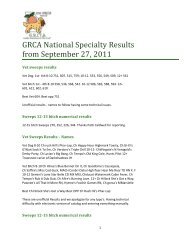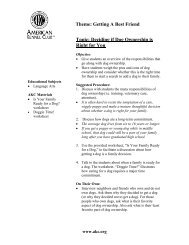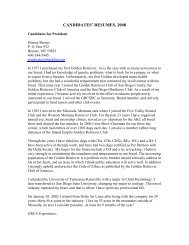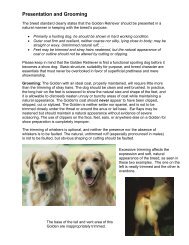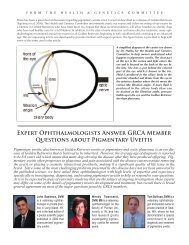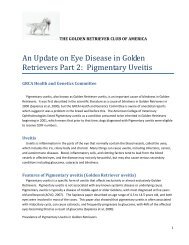Cutting Balloon and High Pressure Balloon Valvuloplasty for Dogs ...
Cutting Balloon and High Pressure Balloon Valvuloplasty for Dogs ...
Cutting Balloon and High Pressure Balloon Valvuloplasty for Dogs ...
Create successful ePaper yourself
Turn your PDF publications into a flip-book with our unique Google optimized e-Paper software.
<strong>Cutting</strong> <strong>Balloon</strong> <strong>and</strong> <strong>High</strong> <strong>Pressure</strong> <strong>Balloon</strong> <strong>Valvuloplasty</strong> <strong>for</strong> <strong>Dogs</strong> with Subaortic<br />
Stenosis<br />
This study is designed to evaluate use of cutting balloon catheters <strong>and</strong> high pressure<br />
balloon catheters in dogs with severe subaortic stenosis in hopes of providing a new<br />
treatment option <strong>for</strong> dogs affected with this congenital heart disease.<br />
Investigators:<br />
M<strong>and</strong>i Schmidt, DVM<br />
University of Florida<br />
Amara Estrada, DVM<br />
University of Florida<br />
Herbert Maisenbacher, VMD<br />
University of Florida<br />
Robert Prošek, DVM<br />
University of Florida<br />
Study Start Date: 02/01/2008<br />
Study End Date: 07/01/2010<br />
<strong>Cutting</strong> <strong>Balloon</strong> <strong>and</strong> <strong>High</strong> <strong>Pressure</strong> <strong>Balloon</strong> <strong>Valvuloplasty</strong> <strong>for</strong> <strong>Dogs</strong> with Subaortic<br />
Stenosis.<br />
Treatment <strong>for</strong> subaortic stenosis in canine clinical patients is frustrating <strong>and</strong> there exists a<br />
great need from both the veterinary community <strong>and</strong> the dog owner/breeder population <strong>for</strong><br />
better treatment options. <strong>Balloon</strong> dilation is a type of interventional procedure used very<br />
commonly, <strong>and</strong> effectively, in veterinary medicine <strong>for</strong> dogs with stenosis of the<br />
pulmonary valve. <strong>Balloon</strong> dilation in dogs with subaortic stenosis however, has not<br />
proven effective or beneficial. New balloon dilation catheters have been developed <strong>for</strong><br />
use in the management of resistant coronary artery, peripheral pulmonary artery, <strong>and</strong><br />
aortic stenosis lesions in humans. The cutting balloon has been modified to have very<br />
small blades, approximately 2mm, which are used to score or cut the stenotic, or<br />
narrowed, tissue when the balloon is maximally inflated. This technique has proven<br />
successful in children <strong>and</strong> young adults with lesions previously resistant to balloon<br />
dilation. The high pressure balloons have been modified with strong materials, such as<br />
kevlar, to sustain an increased burst pressure <strong>for</strong> resistant lesions. This study will<br />
examine these new techniques <strong>and</strong> procedures in dogs with severe subaortic stenosis, in<br />
hopes of providing a new treatment option <strong>for</strong> this currently untreated disease in dogs.<br />
Study Design:<br />
Prospective case series<br />
Inclusion Criteria:<br />
o Echocardiographic evidence of severe subaortic stenosis, (peak trans-stenotic<br />
pressure gradient across the subaortic stenotic region >80mmHg in conjunction<br />
with a subjectively narrowed left ventricular outflow tract)
o Less than 2 years of age. Young patients are preferred as the nature or occurrence<br />
of irreversible pathologic changes causing sudden death with severe subaortic<br />
stenosis is unknown.<br />
o No evidence of any other underlying systemic or metabolic disease.<br />
o No evidence of other congenital heart defects (not including mild aortic<br />
insufficiency or mild mitral valvular regurgitation), myocardial failure, or severe<br />
arrhythmias.<br />
o Patients need to be presented to the University of Florida <strong>for</strong> the procedure <strong>and</strong><br />
follow-up.<br />
Study Controls:<br />
None<br />
Costs/Reimbursements<br />
Patients included in the trial receive at no charge: physical exam, echocardiogram,<br />
electrocardiogram, hospitalization, st<strong>and</strong>ard pre-anesthetic workup prior to high-pressure<br />
balloon valvuloplasty, <strong>and</strong> all expenses associated with recheck exams <strong>and</strong><br />
echocardiograms at 1 month, 3 months, 6 months, <strong>and</strong> 1 year post-balloon valvuloplasty.<br />
Should patients be examined <strong>and</strong> inclusion criteria are not met, owners are responsible<br />
<strong>for</strong> physical exam, echocardiogram, <strong>and</strong> +/- electrocardiogram ($400-500).<br />
PI Contact Info:<br />
M<strong>and</strong>i Schmidt<br />
College of Veterinary Medicine<br />
University of Florida<br />
2015 SW 16th Ave.<br />
Gainesville, FL 32608<br />
Email: schmidtm@vetmed.ufl.edu<br />
Phone: (352)392-2235



